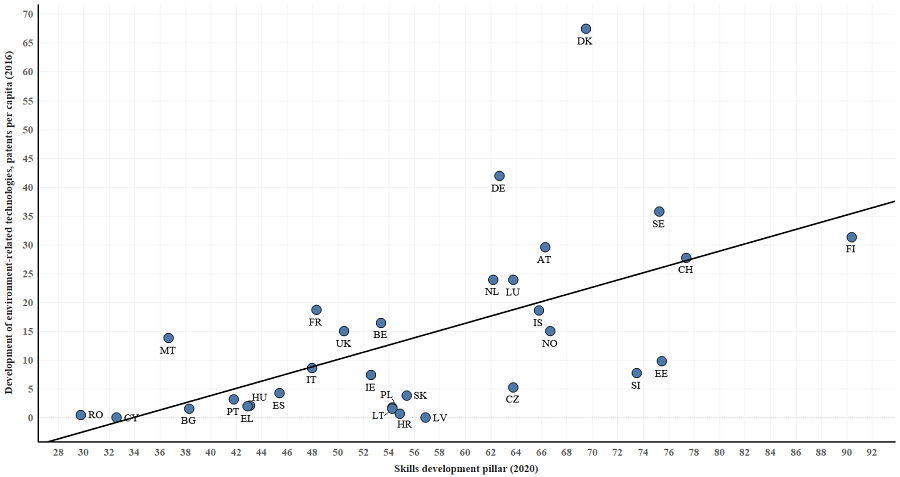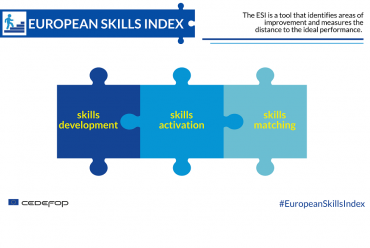Cedefop’s European skills index (ESI) helps predict EU countries’ success in developing green skills by linking a solid national skills development system with faster transition to a green economy.
In December 2019, the European Commission announced its plan for a new European green deal (EGD), aiming to make Europe the first climate-neutral continent by 2050. The EGD involves actions that will help boost the efficient use of resources, slowing down climate change and preserving biodiversity.
A significant amount of investment in the creation and adoption of green technology will be needed. This is expected to give rise to new jobs requiring a high level of skills to develop and operate new technological advancements. Existing occupations will also require acquisition of new and refined skills following the adoption of green technologies. For this reason, the European Commission has recently launched its Pact for skills, an ambitious commitment to support the uptake of next-generation skills, essential for the EU green transition.
The challenge of developing green skills
The EGD inevitably poses an immense challenge for the skills systems of EU Member States, which will be tasked with transforming the skills of the population to meet the needs of the transition into a carbon neutral economy. The question arises of whether countries with better-functioning skills development mechanisms are more inclined towards being greener.
Solid skills development ensures higher-quality education, potentially nurturing environmentally concerned young adults. It also fuels innovation and attracts investment in R&D, which can lead to state-of-the-art green technological advancements. A pool of highly skilled workers will be essential in adopting green technology faster and more efficiently, as long as a county’s public and private sectors take appropriate initiatives towards reducing its carbon footprint.
Cedefop’s ESI predicts countries’ green skills success
To monitor the relative performance of Europe’s skills systems and promote their continuous improvement, Cedefop has developed the ESI, which examines three distinct areas of a country’s skill system: skills development, skills activation, and skills matching. The latest update of the ESI for 2020 covers the EU-27 plus Iceland, Norway, Switzerland and the United Kingdom.
To investigate whether the solid development of skills is linked with the advancement of green technology, Figure 1 shows the link between skills development and an OECD green growth indicator measuring the development of a country’s environmentally related technology in terms of patents-per-capita. A strong positive relation emerges between the two: countries performing better in terms of skills development (as well as in terms of the overall ESI), such as Denmark and Sweden, are also leading the development of green technology. The opposite is true for lower-performing countries. As the development of skills improves, green technology becomes more dispersed across countries. This finding confirms that a strong skills development system is a necessary requirement for the development of green technologies.
Figure 1: Skills development pillar of Cedefop’s European skills index and development of environmentally related technology

Cedefop also addressed the question of whether solid skills development – and consequently the advancement of green technologies – bears fruits in terms of outcomes, by associating skills development with steps towards the adoption of green technology, using non-carbon renewable energy sources. Figure 2 pits skills development against the share of renewable energy in gross final energy consumption (Eurostat 2018 data). A strong and positive relationship emerges between a country’s solid skills development and a greater implementation of carbon-reducing policies, as the latter is captured through greater use of renewable sources in energy consumption.
Figure 2: Skills development pillar of Cedefop’s European skills index and share of renewable energy in gross final energy consumption

As in Figure 1, the performance of countries becomes more dispersed as solid skills systems improve. Some well-performing countries in the development of skills, such as Sweden, Norway and Iceland, appear to engage more heavily in the use of renewable energy in a larger scale, while Estonia, Slovenia, Czechia and Luxembourg (all among the best-performing countries also in terms of the overall ESI) use renewable forms of energy to the same extent as lower-performing countries.
A unique opportunity for countries
These findings suggest that adequate skills development in a country provides a fertile environment for green technologies to be created and implemented. Other factors affecting the widespread use of green technology relate to the high costs and upfront investments required to adopt green technological advancements in the production of energy and its use in buildings, transport and industry sectors.
Cedefop ESI expert Ilias Livanos points out that ‘the European green deal offers countries a once-in-a-lifetime opportunity to overcome cost-related constraints and hop on the train of carbon reduction. Returns on green investments can be accelerated through the development of skills. These two should not be examined in isolation but go hand in hand for successful implementation of the European green deal.’



